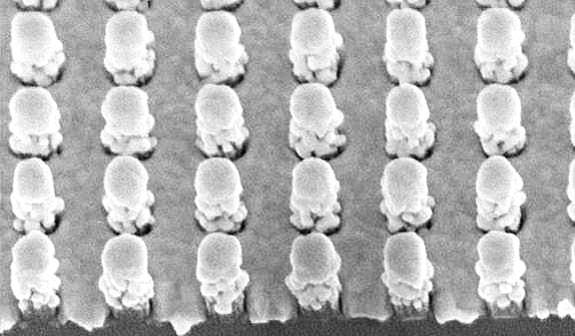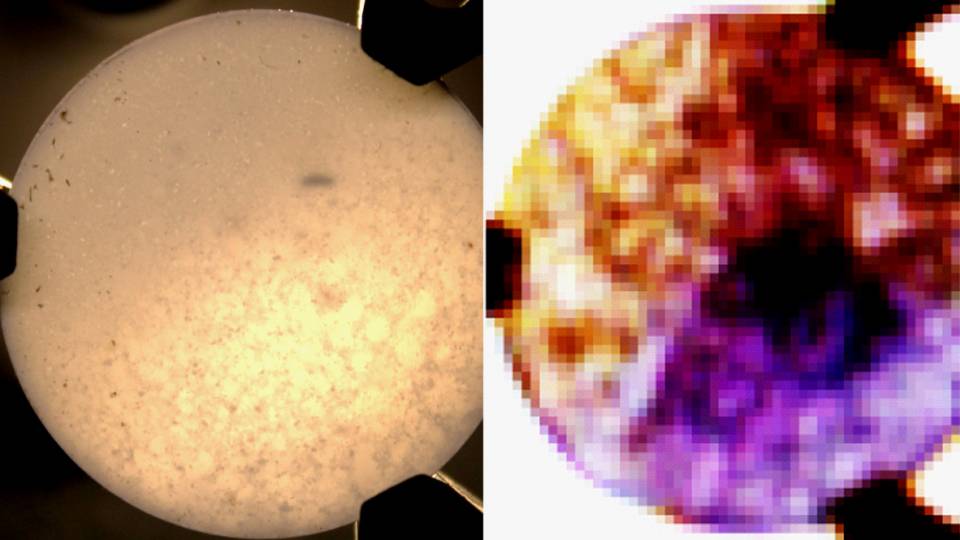Princeton researchers have invented an extremely sensitive sensor that opens up new ways to detect a wide range of substances, from biological markers of cancer to hidden explosives.
The sensor, which is the most sensitive of its kind to date and easy to produce, relies on a completely new architecture and fabrication technique developed by the Princeton researchers. The device boosts faint signals generated by the scattering of laser light from a material placed on the sensor, allowing the identification of various substances based on the color of light they reflect. The sample could be as small as a single molecule.
The technology is a major advance in a decades-long search to identify materials using Raman scattering, a phenomenon discovered in the 1920s by Indian physicist Chandrasekhara Raman, in which light reflecting off an object carries a signature of its molecular composition and structure.

Princeton engineers have developed a sensor, seen in this micrograph, that gathers and amplifies Raman signals, which are wavelengths of light that can be used to identify substances. The sensor relies on a newly designed chip studded with uniform rows of tiny pillars made of metals and insulators. (Photo by Stephen Chou)
"Raman scattering has enormous potential in biological and chemical sensing, and could have many applications in industry, medicine, the military and other fields," said Stephen Chou, the professor of electrical engineering who led the research team. "But current Raman sensors are so weak that their use has been very limited outside of research. We've developed a way to significantly enhance the signal over the entire sensor and that could change the landscape of how Raman scattering can be used."
Chou and his collaborators -- Wen-Di Li, who earned his Ph.D. in 2010; electrical engineering graduate student Fei Ding; and postdoctoral fellow Jonathan Hu -- published a paper on their innovation in February in the journal Optics Express. The research was funded by the Defense Advance Research Projects Agency.
In Raman scattering, a beam of pure one-color light is focused on a target, but the reflected light from the object contains two extra colors of light. The frequencies of these extra colors are unique to the molecular make-up of the substance, providing a potentially powerful method to determine the identity of the substance, analogous to the way a fingerprint or DNA signature helps identify a person.
Since Raman first discovered the phenomenon -- a breakthrough that earned him a Nobel Prize -- engineers have dreamed of using it in everyday devices to identify the molecular composition and structures of substances, but for many materials the strength of the extra colors of reflected light was too weak to be seen even with the most sophisticated laboratory equipment.
Researchers discovered in the 1970s that the Raman signals were much stronger if the substance to be identified is placed on a rough metal surface or tiny particles of gold or silver. The technique, known as surface enhanced Raman scattering (SERS), showed great promise, but even after four decades of research has proven difficult to put to practical use. The strong signals appeared only at a few random points on the sensor surface, making it difficult to predict where to measure the signal and resulting in a weak overall signal for such a sensor.
Abandoning the previous methods for designing and manufacturing the sensors, Chou and his colleagues developed a completely new SERS architecture: a chip studded with uniform rows of tiny pillars made of metals and insulators.
One secret of the Chou team's design is that their pillar arrays are fundamentally different from those explored by other researchers. Their structure has two key components: a cavity formed by metal pieces on the top and at the base of each pillar, which reflect the light back and forth between them like two mirrors; and metal particles of about 20 nanometers in diameter, known as plasmonic nanodots, on the pillar wall, with small gaps of about 2 nanometers between the metal components.
The small particles and gaps significantly boost the Raman signal. The cavities serve as antennae, trapping light from the laser so it passes the plasmonic nanodots multiple times to generate the Raman signal rather than only once. The cavities also enhance the outgoing Raman signal.
Chou's team named its new sensor "disk-coupled dots-on-pillar antenna-array" or D2PA, for short.
So far, the chip is a billion times more sensitive than was possible without SERS boosting of Raman signals and several orders of magnitude more sensitive than other SERS sensors. It also has uniform sensitivity – a key attribute in many applications, further broadening the sensor's usefulness.
Already, researchers at the U.S. Naval Research Laboratory are experimenting with a less sensitive chip based on this new technique pioneered at Princeton to explore whether the military could use this technology for detecting chemicals, biological agents and explosives.
The devices also could be used in medical testing to diagnose diseases. As one example, Chou envisions that tiny sensors injected into a patient’s bloodstream could beam light signals to receivers outside the patient’s body. The signals would alert doctors to the presence of biological markers such as those produced by cancers, avoiding the need for invasive diagnostic surgeries.
In addition to being far more sensitive than its predecessors, the Princeton chip can be manufactured inexpensively at large sizes and in large quantities. This is due to the easy-to-build nature of the sensor and a new combination of two powerful nanofabrication technologies: nanoimprint, a method that allows tiny structures to be produced in cookie-cutter fashion; and self-assembly, a technique in which tiny particles form on their own. Chou's team has produced these sensors on 4-inch wafers (the basis of electronic chips) and can scale the fabrication to much larger wafer size.
"This is a very powerful method to identify molecules," said Chou, who is Princeton's Joseph C. Elgin Professor of Engineering. "The combination of a sensor that enhances signals far beyond what was previously possible, that's uniform in its sensitivity and that's easy to mass produce could change the landscape of sensor technology and what's possible with sensing."
